Industrial laying of water supply: methods of implementation
What is the laying of the water supply under the road and how does it differ from the routing of pipes through construction sites? We will answer this and other equally important questions in this article.
Modern methods of laying water and sewer networks are diverse, and therefore you can choose the method that will most closely match the characteristics of the object in which the tracing and related installation work is carried out.
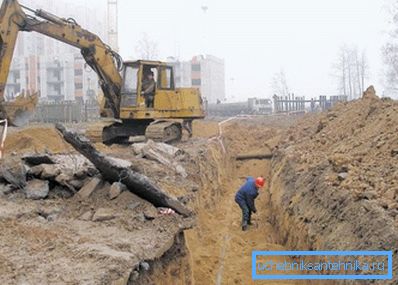
Classification tracing methods

In accordance with the peculiarities of the territory, the presence of the roadway, the intensity of traffic, the parameters of transporting a liquid medium, etc., an open, hidden and closed method of laying pipes is selected and used.
In accordance with the location of the pipeline varies:
- above ground,
- underground,
- underwater tracing method.
Let us consider in more detail the implementation of the listed methods.
Open tracing
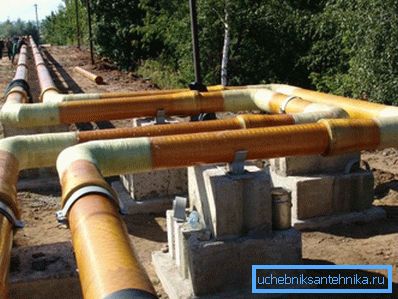
Laying of external plumbing, or as it is also called open tracing, is carried out through the use of specially erected or already existing building structures, such as pillars, walls, racks, etc. In some cases, this method allows the location of the routes through the passage and semi-passage channels, on the surface of the soil or in a trench.
Open ground tracing on the ground, the price of which is most accessible, is as follows:
- fixing on supports or on a specially laid foundation;
- anchoring or installation of cargo on pipes to prevent subsidence of certain sections of the highway and the occurrence of emergency situations;
- installation backfilled with local or imported soil.
The instruction of the open device of water pipes and sewage under transport roads provides for the following methods of organizing construction work:
- with a short stop of traffic on the road (without the need for a detour);
- with stopping traffic in two stages (first one lane overlaps and then the other);
- without stopping traffic (arranged bypass).
Important: Tracing with the intersection of the road in difficult hydrological and geographical conditions is carried out using tunnels. This method of laying the pipeline is good ease of maintenance and repair of the route.
Tracing in a hidden way
Hidden ways of laying water supply networks assume the location of pipes in trenches specially dug for this. In the absence of the possibility of arranging trenches, no channels are used in the walls and under the foundation slab of construction objects.
Important: A significant disadvantage of this solution is difficult access to communications, as the road for repair or maintenance can only be penetrated by fully opening the corresponding structures.
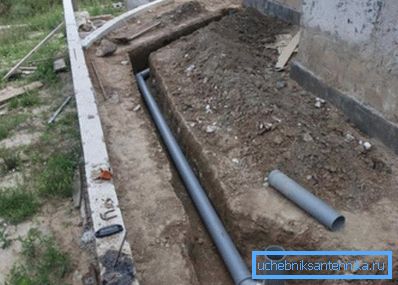
Among the requirements for carrying out excavation work on the construction of pits and trenches, we note the following:
- Trenching should be done without changing the natural structure of the soil;
- If the soil is selected below the level specified by the project, it is allowed to use a sand bedding over the bottom of the trench, but on condition that the layer thickness is no more than half a meter.
- If the soil is selected in accordance with the design depth, the bottom of the trench is lined with a 10 cm thick sand filling.
- The backfill of the pipe is performed from above and on the sides using a protective sand layer with a thickness of 15 to 30 cm, after which the ground is filled up.
- In the process of backfilling, a roller is poured out of unconsolidated soil and is formed, which will settle to the design level in about a year.
- It is not allowed to lay a route in winter time on a frozen foundation.
- Before laying, used pipes and connecting elements must be inspected for defects (chips and cracks).
- Backfilling of the laid route can be performed only after a successful hydraulic test.
- Depending on the diameter of the laid water supply system, backfilling is performed by an excavator or manually.
Tracing in a closed way
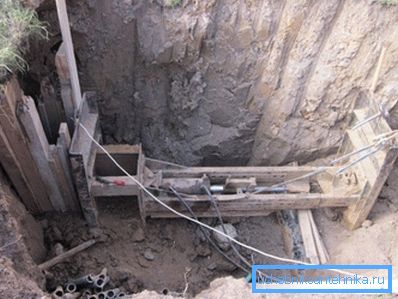
Modern technologies make it possible to lay a route out of pipes of any actual diameters without the need for opening the ground.
Closed routing is performed using one of the following methods:
- shield and tunneling;
- microtunneling;
- puncture with the use of jacks, vibration equipment, mechanized screw puncturer, etc .;
- soil punching by pneumatic punches;
- vacuum vibration pressing of the ground;
- drilling (horizontal, directional, vibrating drilling).
The choice of one of the listed methods of trenchless pipe laying is determined by the diameter and length of the route, the physicomechanical properties and the hydrogeological characteristics of the soil. Again, the choice of method and, as a result, the cost of laying a water pipe per meter is largely determined by the type of equipment available.
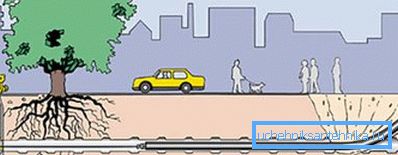
Finally, let us consider in more detail the most effective, and therefore the most popular methods of closed gasket.
- "Pipe in pipe" is a method that allows you to restore a worn out, and even an emergency pipeline without excessive expenses. Sometimes this method is used to build paths that are protected from external mechanical and chemical influences.
- “Puncture” is a popular method of making holes in the ground by means of mechanical punching using specialized equipment.
In order to create a minimum resistance thicker than the ground, the pushing equipment is equipped with a tip of one form or another. As a rule, a smooth metal cone is used as a tip. A pipe is drawn into the taper hole. (See also the article How to choose pipes for heating: features.)
Conclusion
Now you know what a puncture piping is, and how the surface and underground piping is performed. To apply in practice the information obtained, for example, when arranging a water supply system or sewage system with your own hands at the cottage.
There are questions for which you need comprehensive answers? More useful information can be found by watching the video in this article.